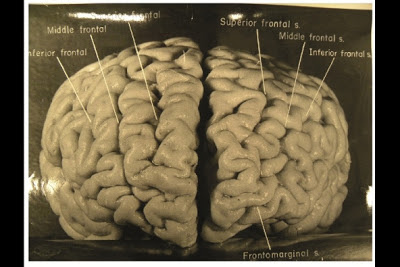My favorite case from the 2012 AANP
Diagnostic Slide Session in Chicago last month featured an autopsy slide from the brain of a 25-year-old man with a
history of polysubstance abuse found unresponsive at a New Year's Eve
party. Toxicology screening was positive for methadone, lorazepam, and
cocaine. The patient died after three weeks in the intensive care unit.
Attendees were provided glass slides in advance of the session demonstrating the following findings:
 |
| Low Power: Marked white matter pallor |
 |
| High Power: White matter virtually replaced by lipidized macrophages |
Presenter
Joshua Menke, MD
of The Mayo Clinic (Rochester, MN) revealed that white matter damage
was diffuse, including infratentorial structures. The subcortical
U-fibers were relatively spared and myelin was disproportionately
affected as compared to axons, as demonstrated in these photomicrographs
from Dr. Menke's presentation:
 |
| LFB stain on left and neurofilament stain on right |
Discussants included Drs.
Tessa Hedley-Whyte,
Craig Horbinski,
Mark Cohen,
and others. Before the diagnosis was revealed, Dr. Horbinski stated
that he thought Delayed Hypoxic Leukoencephalopathy might be the best
fit for this case. Dr. Cohen pointed out that Delayed Hypoxic
Leukoencephalopathy tends spare the infratentorial regions, while the
white matter damage is more diffusely distributed in toxic
leukoencephalopathy. This case was ultimately revealed to be that of
Toxic Spongiform Leukoencephalopathy.
Toxic leukoencephalopathy can be caused by a range of insults including
radiation, chemotherapy, and drugs of abuse. Among the drugs of abuse
that have been shown to cause toxic leukoencephalopathy are toluene,
ethanol, cocaine, 3,4-methylenedioxy-methamphetamine, intravenous
heroin, inhaled heroin pyrolysate, and psilocybin (
Ref: Filley & Kleinschmidt-DeMasters NEJM 2001).
Toxic spongiform leukoencephalopathy is a clinicopathologic entity
first associated with the inhalation of pyrolysate heroin vapors, a
practice which had its origins in Hong Kong in the 1950's and which came
to be known colloquially as "chasing the dragon". Users typically
"chase the dragon" by placing heroin on a creased piece of tin foil over
a flame. As the drug sublimates, the user inhales the fumes. The
pathophysiology of this form of leukoencephalopathy has not been clearly
elucidated, but is thought to be related to a direct toxic effect of
heroin on oligodendrocytes.

































